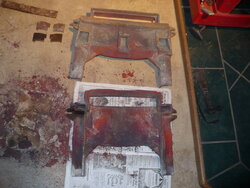Hello Anyone,
I own an older Harman TL200 and am in dire need to find out what this red clay insulating material is that's been applied to the Afterburner Hood Weldment(Cast Iron) from the Harman factory back in 2008(Last year TL200 produced) as it's clearly NOT a hard cement as I was told from Harman stove dealer's because it's pliable/soft,staining and I'm trying to find out if anyone know's where to buy this red clay...Is it similar to 3M Fire Barrier Sealant CP 25WB+ Intumescent ?
My wish is to obtain advise on whether I should remove ALL this red clay sealant application that's on this cast iron weldment and just apply an insulating furnace cement like Rutland or Hercules then affix the ceramic silicate insulation board or blanket upon reassembly.
I have a suspicion that furnace cement will not adhere to this red clay insulation ?
I hope to receive some type of assistance as my wood stove's down and as of Feb. 26 thru Mar. 26 I've burned up 125 Gal. of #2 heating oil (Rancher's Thermostat set between 60-65 degrees F) .
I'd greatly appreciate any clarity on this mystery red clay as I know this cast iron piece is a bit warped,I try real hard never to overfire at 600 deg. F,and must get this stove operational again.
I love this Top-Load wood stove and am stuck with it as money's tight.
I own an older Harman TL200 and am in dire need to find out what this red clay insulating material is that's been applied to the Afterburner Hood Weldment(Cast Iron) from the Harman factory back in 2008(Last year TL200 produced) as it's clearly NOT a hard cement as I was told from Harman stove dealer's because it's pliable/soft,staining and I'm trying to find out if anyone know's where to buy this red clay...Is it similar to 3M Fire Barrier Sealant CP 25WB+ Intumescent ?
My wish is to obtain advise on whether I should remove ALL this red clay sealant application that's on this cast iron weldment and just apply an insulating furnace cement like Rutland or Hercules then affix the ceramic silicate insulation board or blanket upon reassembly.
I have a suspicion that furnace cement will not adhere to this red clay insulation ?
I hope to receive some type of assistance as my wood stove's down and as of Feb. 26 thru Mar. 26 I've burned up 125 Gal. of #2 heating oil (Rancher's Thermostat set between 60-65 degrees F) .
I'd greatly appreciate any clarity on this mystery red clay as I know this cast iron piece is a bit warped,I try real hard never to overfire at 600 deg. F,and must get this stove operational again.
I love this Top-Load wood stove and am stuck with it as money's tight.



